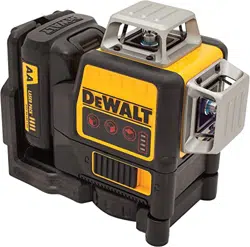Loading ...
Loading ...
Loading ...

10
EN
Using the Lasers with Accessories
The lasers are equipped with 1/4” - 20 and 5/8” - 11 female threads on
the bottom of the unit. This thread is to accommodate current or future
DeWALT accessories. Only use DeWALT accessories specied for use
with this product. Follow the directions included with the accessory.
CAUTION:
The use of any other accessory not recommended for use
with this tool could be hazardous.
If you need any assistance in locating any accessory, please contact
your nearest DeWALT service center or go to
www.2helpU.com on the Internet.
Leveling the Lasers
As long as the laser is properly calibrated, the laser is self-leveling.
Each laser is calibrated at the factory to nd level as long as it is
positioned on a at surface within average ± 4° of level. No manual
adjustments are required.
Maintenance
• To maintain the accuracy of your work, check the laser often to
make sure it is properly calibrated. See Field Calibration Check.
• Calibration checks and other maintenance repairs may be
performed by DeWALT service centers.
• When not in use, store the laser in the kit box provided. Do not
store your laser at temperatures below -5˚F (-20˚C ) or above 140˚F
(60˚C).
• Do not store your laser in the kit box if the laser is wet. The laser
should be dried first with a soft dry cloth prior to storage.
Cleaning
Exterior plastic parts may be cleaned with a damp cloth. Although
these parts are solvent resistant, NEVER use solvents. Use a soft, dry
cloth to remove moisture from the tool before storage.
Accuracy Check and
Calibration
Checking Accuracy –
Horizontal Beam, Scan Direction (See gure
7
)
Checking the horizontal scan calibration of the laser requires two walls
9m (30’) apart. It is important to conduct a calibration check using a
distance no shorter than the distance of the applications for which the
tool will be used.
1. Place the laser on a smooth, flat, stable surface that is level in
both directions, with the laser facing straight ahead toward the
opposing wall (0 degree position).
2. Turn on the laser’s horizontal beam and pivot the laser toward the
opposite end of the wall and approximately parallel to the adjacent
wall (Figure
7
#1).
3. Mark the center of the beam at two locations (
a
,
b
) at least
30’ (9m) apart.
4. Pivot the laser 180 degrees and mark the horizontal beam position
on the opposing wall
c
(Figure
7
#2).
5. Measure the vertical distance between
b
and
c
. If the
measurement is greater than the values shown below, the laser
must be serviced at an authorized service center.
Distance Between Walls Allowable Distance
Between
b
and
c
30’ (9m) 1/4” (6.0mm)
40’ (12m) 5/16” (8.0mm)
50’ (15m) 13/32” (10.0mm)
6. Rotate the laser 90 degrees and repeat the test.
Checking Accuracy –
Horizontal Beam, Pitch Direction (See gure
8
)
Checking the horizontal pitch calibration of the laser requires a single
wall at least 30’ (9m) long. It is important to conduct a calibration check
using a distance no shorter than the distance of the applications for
which the tool will be used.
1. Place the laser on a smooth, flat, stable surface that is level in
both directions.
2. Turn on the laser’s horizontal beam and pivot the laser toward
the opposite end of the wall and approximately parallel to the
adjacent wall (Figure
8
#1).
Loading ...
Loading ...
Loading ...
